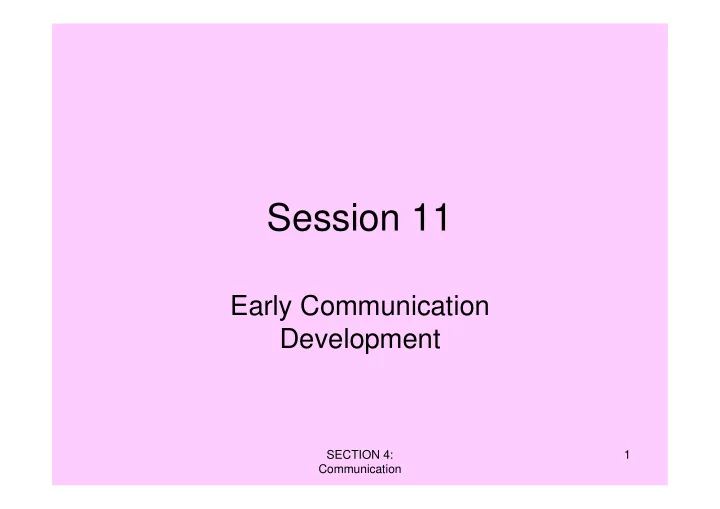

Session 11 Early Communication Development SECTION 4: 1 Communication
Communication in its widest sense • Make a list of all the different ways in which we communicate with each other speech, gesture, touching, pointing…….. SECTION 4: 2 Communication
Typical infants 0-6 months • People coo and smile at babies and have fun • Babies are born wanting to look at faces • Intense eye contact is established by 6 weeks • Burps, wiggles and sounds are responded to by adults as early ‘conversations’ SECTION 4: 3 Communication
Typical infants 6-12 months • Care givers select what they respond to a bit more • Babies begin to realise their actions have effect on people • They ask for things with gestures and sounds • They comment on things too and indicate ‘no’ SECTION 4: 4 Communication
Typical toddlers 12 months plus • Proto-words come first eg: ‘gar’ for garden but also meaning ‘I want to get out’ • Single words 12-18 months eg: dadda meaning ‘where’s daddy?’, ‘here’s daddy’ ‘I want daddy’ etc • Joining words together 18-24 months ‘mummy coat’ meaning ‘this is mummy’s coat’, ‘put your coat on mummy, I want to go out’. • First words and sentences are usually the child’s needs and wishes SECTION 4: 5 Communication
Important things to note • Communication skills grow out of experience of social interaction. Parents don’t wait until their babies can speak before they include them in the conversation. • Babies can be very effective communicative partners long before they have words. • Babies are encouraged to be partners in conversation and to take turns. They are not expected to be quiet and listen and learn language without participating. • The best ‘conversations’ with babies are focused on things that are meaningful to babies and fun. SECTION 4: 6 Communication
Learning to communicate is more than learning a few words or signs 1. Arrange for a communication assessment 2. Make conversation fun and interactive. Give adults the chance to take their turns wherever possible; give them a chance to express a choice. 3. Be very alert to any attempts the adult makes to communicate and wherever possible respond quickly. 4. Try and have a clear method for letting service users control their activities through communication. It is very important that adults have a method for calling you over when they want attention, and sending you away when they want to be alone. Asking for more or less of activities is also very important. SECTION 4: 7 Communication
Recommend
More recommend